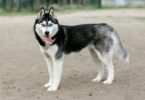Over 60% of families searching for pets express specific interest in canine companions with two-tone coats, according to recent adoption surveys. These distinctive animals often become instant favorites due to their striking appearance and adaptable temperaments.
Coat patterns like brown-and-white combinations aren’t just visually appealing—they can signal unique breed traits. Genetics influence both coloration and personality characteristics, making these pets fascinating subjects for owners seeking loyal companions.
This guide explores popular breeds sporting this classic color scheme. Readers will discover:
• Key health considerations for maintaining vibrant coats
• Grooming strategies tailored to mixed-color fur
• Behavioral patterns linked to specific lineages
From understanding exercise needs to recognizing early signs of common conditions, the information here helps owners make informed decisions. Multiple veterinary studies and breeder insights inform these practical recommendations.
Whether preparing for a new family member or optimizing care for an existing pet, this resource combines scientific data with real-world advice. Explore how coat genetics intersect with overall wellness in these remarkable animals.
Overview of Brown and White Dog Colors and Genetics
Genetics play a pivotal role in creating the eye-catching patches seen on many family pets. Distinctive markings result from inherited gene combinations that control pigment distribution. These biological blueprints explain why some companions display crisp contrasts while others show blended transitions.
Decoding Pattern Diversity
Two-tone coats appear in multiple configurations. Piebald patterns create irregular white areas with colored patches, often seen in Beagles. Merle genes produce mottled effects with darker swirls against lighter backgrounds, common in Australian Shepherds.
Genetic Drivers of Appearance
Specific DNA sequences determine coat characteristics. The S-locus gene governs white spotting extent, while B-locus variants influence pigment intensity. Not all mixed-color canines carry tricolor genes—some exhibit only two shades due to recessive traits.
Border Collies demonstrate how these genes interact. Their typical markings combine solid areas with precise white accents. Understanding these mechanisms helps owners appreciate their pet’s unique biological heritage.
Key Characteristics of the Brown and White Dog
Tricolor canines captivate admirers with their striking visual harmony and dynamic personalities. These companions often display defined markings that enhance their expressive features, from symmetrical facial masks to bold chest patches. Coat textures vary widely—some sport silky fur perfect for showing, while others have weather-resistant double layers suited for outdoor activities.
Enthusiasts celebrate tricolor patterns for their artistic appeal and genetic uniqueness. A Beagle’s classic saddle marking contrasts sharply with a Springer Spaniel’s freckled legs, proving diversity exists within this color category. Such variations often correlate with breed history—hunting lineages might showcase camouflage-friendly patterns, while companion breeds favor symmetrical designs.
Temperament frequently mirrors physical traits in these animals. Many exhibit balanced energy levels, blending playful curiosity with calm attentiveness. Owners report intelligent problem-solving skills in herding breeds, contrasted by affectionate loyalty in smaller companion types. Health remains unaffected by coat hues when responsible breeding practices prioritize genetic screening.
Personality shines through beyond aesthetics. A well-socialized tricolor companion might demonstrate surprising adaptability in multi-pet households or excel in agility training. Regular vet checkups and tailored exercise routines help maintain both vibrant coats and lasting vitality across all life stages.
Popular Breeds with Brown and White Coats
Nearly 40% of U.S. households prioritize temperament when selecting pets, per the American Pet Products Association. Distinctive two-tone companions offer both visual charm and personality traits suited to different lifestyles. Matching energy levels and care requirements ensures lasting harmony between owners and their furry friends.
Family-Friendly and Companionable Breeds
The Pembroke Welsh Corgi charms families with its fox-like face and adaptable nature. These sturdy companions thrive in homes with children, displaying patience and moderate exercise needs. Regular brushing maintains their weather-resistant double coat.
Cavalier King Charles Spaniels excel as lap warmers with silky, feathered fur. Their affectionate demeanor suits apartment living, though routine ear cleaning prevents infections. Responsible breeders screen for heart conditions common in this lineage.
Active and Energetic Varieties
English Pointers showcase athletic builds ideal for hiking partners. Their short, speckled coats require minimal grooming but demand daily mental stimulation. These sporting breeds flourish with owners who enjoy outdoor adventures.
American Cocker Spaniels blend striking feathering with playful energy. Their cheerful disposition shines during fetch games, while weekly trims keep furnishings tangle-free. Early socialization helps manage their strong hunting instincts.
Choosing between these breeds depends on activity preferences and grooming commitment. A Pembroke Welsh companion might suit busy professionals, while a King Charles Spaniel better fits relaxed households. Always verify health clearances with reputable sources.
Breed Descriptions and Health Stats
Key physical and behavioral metrics guide potential adopters in selecting compatible companions. These measurements reveal essential details about space requirements, activity levels, and long-term care commitments.
Standardized Measurements for Comparison
Consider these profiles for popular two-tone breeds:
Beagle
Height: 13-15 inches
Weight: 20-30 lbs
Lifespan: 12-15 years
Temperament: Curious, vocal, family-oriented
Cocker Spaniel
Height: 14-15 inches
Weight: 20-30 lbs
Lifespan: 10-14 years
Temperament: Gentle, adaptable, thrives on attention
Height in inches indicates space needs, while lifespan in years helps plan veterinary budgets. Smaller breeds under 15 inches often suit apartments, whereas those living 12+ years require sustained care commitments.
Temperament details predict compatibility. High-energy types need daily exercise, while calmer varieties excel in relaxed homes. Tracking weight ranges helps identify growth abnormalities early.
These metrics empower owners to match their lifestyle with a breed’s natural tendencies. Always cross-reference statistics with breeder health certifications for accuracy.
Health Considerations for Brown and White Dogs
Studies indicate that pets with mixed-coat pigmentation may face unique health challenges requiring attentive care. While their striking appearance draws admiration, specific genetic factors influencing coloration can impact wellness. Proactive measures help address these concerns effectively.
Common Health Concerns and Allergies
Skin sensitivity often accompanies distinct coat patterns. Light-pigmented areas might lack protective melanin, increasing sunburn risks. Regular inspections for rashes or dryness help catch issues early. Allergy-prone pets benefit from hypoallergenic diets and fragrance-free grooming products.
Daily exercise maintains healthy weight and joint function. Activities like leash walks or fetch sessions strengthen leg muscles while preventing obesity. Overweight pets risk leg joint strain, particularly in breeds with shorter limbs.
Monitor mobility during playtime. Stiffness after rest or reluctance to climb stairs could signal leg-related discomfort. Schedule vet visits if limping persists beyond 48 hours. Early intervention prevents chronic conditions.
Subtle signs like excessive scratching or appetite changes warrant attention. Keep a symptom journal to share with veterinary professionals. Annual checkups should include skin evaluations and leg joint assessments.
Preventive care extends beyond vaccinations. Discuss breed-specific supplements with your vet—omega fatty acids support skin health, while glucosamine aids leg mobility. Tailored wellness plans address individual needs while preserving those iconic coat patterns.
Grooming and Care Tips
Maintaining a vibrant two-tone coat requires tailored strategies that balance aesthetics with skin health. Proper care enhances natural patterns while preventing common issues like matting or dryness. A structured routine helps preserve both the visual appeal and physical comfort of your furry companion.
Essential Grooming Practices for a Shiny Coat
Weekly brushing forms the foundation of coat maintenance. Use a slicker brush for silky fur types or a de-shedding tool for thicker coats. This process distributes natural oils evenly, keeping patches distinct and preventing tangled strands.
Bathe companions every 4-6 weeks using oatmeal-based shampoos. These formulas cleanse without stripping essential moisture. Always follow with conditioner on darker sections, which tend to show dryness first. Blow-dry on low heat to maintain texture.
Detangling sprays work wonders for wiry coats between washes. Focus on areas behind ears and under legs where knots form. Regular trims around paw pads and sanitary regions improve hygiene without altering signature markings.
Make sure grooming sessions include skin checks. Look for flakiness or redness, especially along color transitions. Wipe facial folds daily with hypoallergenic wipes to prevent bacterial growth in wrinkled breeds.
Schedule professional grooming every 6-8 weeks for complex trims. Experts can shape furnishings while preserving pattern integrity. This consistency reduces shedding and helps identify potential health issues early.
Training and Socializing Your Canine Companion
Effective training transforms energetic pups into well-mannered family members. Structured socialization builds confidence in young companions, helping them adapt to various situations. Both processes strengthen the bond between pets and their households while preventing behavioral issues.
Reward-Based Training Techniques
Start with short 5-minute sessions using high-value treats. Mark desired behaviors like “sit” or “stay” with a clicker or verbal praise. Immediate rewards create clear associations between actions and positive outcomes.
Consistency proves crucial for obedience development. Use identical commands and hand signals during daily practice. Gradually increase difficulty by introducing distractions once basic skills solidify.
Socialization requires exposure to diverse stimuli before 16 weeks of age. Introduce your companion to various surfaces, sounds, and friendly strangers. Reward calm reactions during these encounters to reinforce adaptability.
Group classes offer structured environments for practicing manners. Well-run sessions teach leash etiquette and polite greetings. These experiences help companions become comfortable in busy public spaces.
Early training impacts lifelong behavior patterns. Pets mastering basic commands integrate smoothly into family routines. Proper socialization reduces anxiety during vet visits or travel, creating happier household dynamics.
Exercise Needs and Energy Management
Balancing physical activity with rest periods proves essential for pets displaying vibrant coat patterns. Energy levels vary significantly across breeds—a brown Husky might require triple the exercise of a similarly colored Basset Hound. Matching movement requirements to your schedule prevents destructive behaviors in high-energy companions.
Active breeds thrive on 60-90 minutes of daily exertion. Combine leash walks with interactive play sessions to engage their minds. Sedentary types often stay content with 20-30 minutes of gentle strolls paired with puzzle toys.
High-energy pets benefit from structured routines. Alternate jogging days with agility training or scent games. These activities channel natural instincts productively while burning excess energy. Calmer breeds prefer short, frequent outings that maintain joint health without overexertion.
Weather-resistant companions enjoy hiking adventures, while heat-sensitive varieties need shaded morning walks. Always provide fresh water and watch for overheating signs like excessive panting.
Busy owners can integrate exercise through multiple 10-minute play breaks. Fetch sessions during lunch hours or evening obedience drills effectively meet daily needs. Consistent activity schedules improve behavior and strengthen owner-pet bonds across all energy levels.
Choosing the Perfect Brown and White Dog for Your Family
Finding the right two-colored pet requires matching their needs with your household dynamics. Consider energy levels, space availability, and daily schedules before committing. Families with young children often benefit from calm breeds, while active singles might prefer athletic companions.
Adoption Essentials and Household Compatibility
Evaluate living conditions first. Compact apartments suit smaller breeds, while houses with yards accommodate energetic types. Measure your space and compare it to breed-specific exercise requirements. Noise levels and neighbor proximity also influence suitability.
Personality traits matter as much as appearance. Visit shelters during quieter hours to observe true temperaments. Look for signs of adaptability, like relaxed body language around new people. Ask staff about each animal’s history with kids or other pets.
Rescue organizations often provide behavioral assessments. These insights help match families with companions fitting their lifestyle. Prioritize pets showing curiosity during meet-and-greets—this indicates trainability.
Consider long-term commitments beyond initial attraction. A puppy’s striking markings might captivate, but their adult size and grooming needs impact daily living. Discuss care routines with adoption counselors to ensure alignment with your capabilities.
Genetic Factors Influencing Coat Colors and Blue Eyes
Understanding the genes that shape your companion’s appearance can unlock vital health insights. Specific DNA sequences control both visible traits and underlying wellness factors, creating connections between striking coats and potential medical considerations.
Merle and Piebald Genes in Canine Coats
The merle gene creates mottled patterns by diluting random pigment areas, often producing blue eyes. Breeds like Australian Shepherds display this trait, though double merle pairings risk hearing or vision loss. Piebald markings result from incomplete pigment spread, leaving white base coats with tan patches—common in Jack Russell Terriers.
Tan and tan white patterns emerge through different genetic pathways. Pheomelanin pigments create these warm hues, while specific modifiers determine their placement. Certain hunting breeds inherit these shades as camouflage advantages, blending into autumn foliage during field work.
Inherited Traits and Their Health Implications
Pigmentation genes sometimes link to sensory health. Dogs with extensive white markings may face higher deafness rates due to inner ear cell deficiencies. Charles Spaniels with roan coats require regular skin checks, as their light areas show irritation faster than darker fur.
Breeders prioritize genetic testing to avoid compounding risky traits. For example, pairing two merle carriers might produce puppies with eye abnormalities. Responsible Charles Spaniel enthusiasts screen for conditions like dry eye syndrome, which occasionally correlates with coat color genetics.
Subtle connections exist between coloration and behavior. Some tan-marked retrievers exhibit enhanced scent tracking—a trait historically favored in hunting lineages. Always discuss genetic health screenings with your vet to address breed-specific risks proactively.
Exploring Tricolored and Multi-Coat Dog Breeds
Tricolored coats turn heads in competition rings, blending form and function with striking artistry. These multi-patterned companions often showcase genetic complexity through their layered markings, creating visual depth that enhances their stage presence during events.
Understanding Tricolor Patterns and Their Appeal
Three-tone fur combinations create natural focal points that emphasize movement. Symmetrical face masks or contrasting tail tips help judges track precise maneuvers in agility trials. Such patterns originated from selective breeding for both aesthetics and working ability in historical herding breeds.
Agility athletes like Border Collies often use their plumed tails as balance aids during sharp turns. The tail’s visibility against multi-colored fur improves handler communication during high-speed courses. In contrast, single-colored competitors might blend into obstacle backdrops, though coat hues don’t affect actual performance metrics.
Popular sports breeds demonstrate how diverse patterns coexist with athleticism. Long-haired Dachshund puppies often inherit tricolor genes that later complement their earthdog trial performances. Australian Shepherds use merle-tri combinations to stand out in disc-catching exhibitions while maintaining peak responsiveness.
While coat colors don’t dictate skill, they influence spectator engagement and breed recognition. Multi-patterned pets frequently become ambassadors for canine sports, inspiring new enthusiasts through their vibrant appearance and dynamic abilities.
Reflections on a Life with Your Brown and White Dog
Sharing your home with a two-toned companion brings a unique blend of joy and purpose. These loyal friends enrich daily routines through their unwavering devotion, whether curling up after work or greeting you with enthusiastic tail wags. The journey from selection to lifelong care creates bonds that outlast seasonal trends in pet ownership.
Owning such pets involves thoughtful stewardship. Regular grooming preserves their signature patterns, while proactive health checks address breed-specific needs. Training builds mutual understanding, transforming playful energy into focused cooperation. A border collie’s ability to switch from herding to couch cuddling demonstrates this versatility.
Families gain a lot through this partnership—structured routines, laughter-filled playtimes, and quiet moments of connection. The border collie exemplifies how intelligence and adaptability create rewarding relationships. A lot of satisfaction comes from witnessing their unique personalities flourish under attentive care.
Prospective owners should weigh the lot of responsibilities against these rewards. When matched thoughtfully, two-colored companions become irreplaceable family members, offering years of loyalty and love shaped by their genetic heritage.
FAQ
How do genetics influence brown and white coat patterns in dogs?
Genes like piebald or merle often create tricolor or multi-coat variations. Specific alleles determine pigment distribution, resulting in patches, spots, or blended shades. Breeds like the Australian Shepherd showcase merle patterns linked to these genetic traits.
Which breeds with brown and white coats are best for active families?
High-energy breeds like Border Collies and Pembroke Welsh Corgis thrive in active households. Their stamina suits agility training, hiking, or obedience sports. Always match a breed’s exercise needs to your lifestyle for optimal compatibility.
Are there health risks tied to specific coat colors in dogs?
Merle-patterned coats, seen in breeds like the Australian Shepherd, sometimes correlate with hearing or vision issues. Reputable breeders screen for inherited conditions. Regular vet checkups help manage allergies or skin sensitivities common in tricolor breeds.










Leave a Comment